Keywords
|
| Piezoelectricity, PZT, PVDF, actuator |
INTRODUCTION
|
| Nowadays efficient use of energy is a concern field of research. In vibration applications we observe different vibration of motors, structural part of aircrafts, automobiles as unaccounted energy. Coming to specially vibration of aircraft structures are buffet and fluttering. Buffet is a type of random vibration which is usually caused by an interruption of airflow. It is often felt when the aerodynamic brakes are used or when the aircraft flies through the turbulence. Flutter is an unstable condition in which unsteady aerodynamics excite the natural frequencies of the structure over which air flows. The resulting vibrations can grow to a magnitude that causes the structure to fail. The energy wasted due to all these types of vibrations can be used effectively by energy harvesting system [1]. |
| Energy harvesting is the conversion of ambient energy present in the environment into electrical energy. By converting ambient energy in the environment the energy harvester can provide the required electrical power for the lifetime of the wireless system which is also free to be embedded or placed wherever it is best suited to program its functions. Energy harvesting system converts energy from ambient sources like 1) mechanical 2) thermal 3) environmental 4) biological. Among these the mechanical energy harvesting can be taking place by piezoelectric conversion, electromagnetic conversion, magnetic conversion, electrostatic conversion [2]. |
| Piezoelectric materials have received the most attention due to their ability to directly convert applied strain energy into usable electrical energy is called piezoelectric effect and conversely undergo deformation when an electric field is applied across them. This is called converse piezoelectric effect. Thus they can be used both as sensors and actuators [3]. Piezoelectric energy harvesting system includes a transducer to convert kinetic energy into electrical energy and electrical interface to manage this energy, which includes rectifier and voltage regulator. Basic piezoelectric energy harvesting system is shown in Fig: 1. Transducer means, it is a sensor which transfer the vibrating energy into electrical energy. Output of the transducer that is the electrical energy is strong and irregular function of time. Hence ac-dc converter is required. The output from the rectifier is stored in the battery or capacitor for other applications. Voltage regulator is needed to regulate suitable voltage. |
 |
| In this paper the vibration of a structure was generated using PZT film as actuator. By applying voltage to the PZT film at different frequencies generates the vibration corresponding to polarization of the crystal along with mechanical deformation of the molecule. PVDF films are used as sensors for harvesting energy from vibrations. Here PVDF films with different dimensions are used. Experiments are carried out on an aluminum cantilever beam and energy is measured by different PVDF film and based on this comparative study is carried out. |
PIEZOELECTRIC CONVERSION
|
| Direct piezoelectric effect is shown in the Fig: 2. Here stress to charge conversion is taking place [4]. |
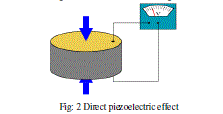 |
| Different piezoelectric materials available are naturally occurring crystals, manmade ceramics and polymers. Naturally occurring piezoelectric materials are Berlinite, Cane sugar, Quartz and Rochelle salt. Man made ceramics are Barium titanate, Lead titanate, Lead Zirconate Titanate (PZT) and Lithium niobate. Polymers are Polyvinylidene Fluoride (PVDF). A majority of piezoelectric generators have been fabricated and tested using some variation of PZT. Piezoelectric energy harvesters can work in either d33 mode or d31 mode as shown in Fig: 3 [4]. |
 |
| In d31 mode a lateral force is applied in the direction perpendicular to the polarization direction. In d33 mode force applied is in the same direction as the polarization direction. Piezoelectric energy harvesters have high output voltage but low current level. They have simple structure. However most of the piezo materials have poor mechanical properties. Therefore the life-time is a big concern for piezoelectric energy harvesters. Piezoelectric energy harvesters normally have very high output impedance, which makes it difficult to couple with follow on electronics efficiently. Commonly used material for piezoelectric energy harvesting are BaTiO3, PZT-5A, PZT-5H, Polyvinylidene fluoride (PVDF). |
PROPERTIES OF PZT ACTUATOR
|
| Lead zirconium titanate is an inorganic compound with the chemical formula Pb[ZrxTi1-x]O3 (0≤x≤1). Also called PZT, it is a ceramic perovskite material that shows a marked piezoelectric effect, which finds practical applications in the area of electro ceramics. It is a white solid that is insoluble in all solvents. The dielectric constant of PZT can range from 300 to 3850 depending upon orientation and doping. The material exhibits an extremely large dielectric constant at the morphotropic phase boundary (MPB) near x=0.52. The increased piezoelectric response and poling efficiency near x=0.52 is due to the increased number of allowable domain states at the MPB [5]. PZT actuator used for this experiment was manufactured by Sparkler Ceramic Ltd, Pune. Sparkler manufactures piezoelectric ceramics based on the solid solutions of Lead Titanate (PbTiO3) and Lead Zirconate (PbZrO3) which are popularly known as PZT. These are manufactured from their respective oxides/carbonates of Pb, Zr, Ti, rare earths, alkaline earths, transition metals etc. to the specified compositions well tuned to the end properties, by mixing and solid state reactions [6]. |
| PZT actuator converts electrical signals into mechanical displacements or forces. The operating frequency range of actuators is from static up to about half the resonant frequency of the mechanical system. PZT actuators can divide into |
| three main groups as axial (d33 mode), transversal (d31 mode), and flexural (d31 mode). First and second actuators have high stiffness and are used for small movements and high forces. The flexural is used where larger movements are required [7]. PZT possess high dielectric constant, high dielectric permittivity and strong electromechanical coupling ensuring good actuation capabilities. But PZT is brittle, non-flexible and cannot be formed onto curved surface, limiting design flexibility of the transducers. |
PVDF- ENERGY CONVERTER
|
| Polyvinylidene fluoride or Polyvinylidene difluoride (PVDF) is a highly non-reactive and pure thermoplastic fluoropolymer produced by the polymerization of vinylidene difluoride. PVDF is a specialty plastic material in the applications requiring the highest purity, strength and resistance to solvents, acids, bases and heat and low smoke generation during a fire event. It has low density (1.78) and low cost compared to other fluoropolymers. PVDF exists in several forms alpha (TGTG), beta (TTTT) and gamma (TTTGTTTG) phases depending on the chain conformations as Trans (T) or gauche (G) linkages. Processed materials are typically in the non piezoelectric alpha phase. The material must either be stretched or annealed to obtain the piezoelectric beta phase. |
| Unlike PZT, PVDF has a negative d33 value. Physically this means that PVDF will compress instead of expand or vice versa when exposed to the same electric field [8]. PVDF pressure sensor has high sensitivity to pressure, low sensitivity to temperature, and linear response to the pressure and has no phase transition at the operation temperature. PVDFs are lighter in weight and more flexible compared to PZT [9]. PVDF is typically a member of the family of alkenes exhibiting high piezoelectric properties. It can be prepared into any forms like needles, tubes, fibers, and paints or formed into a sensor package itself. Thus based on the application and space available PVDF can be fabricated into various shapes and sizes. These features make it more popular in energy harvesting [11]. |
EXPERIMENTAL SETUP
|
| In order to investigate the impact of dimension of PVDF film on energy harvesting application the experimental setup needed is as shown in the Fig: 4. It consists of aluminum beam mounted on the table using a C-clamp. PZT film used as actuator is mounted on the bottom of this beam. PVDF film acts as sensor is mounted on the top of this film. Signal generator is used to give the input necessary for actuator operation. The output from the PVDF is observed on the oscilloscope. |
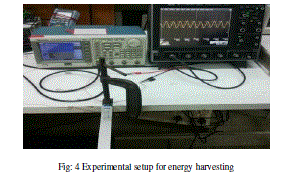 |
| Three different dimensional PVDF films are used. For this experiment three aluminum beams are used but with same dimension. The actuator PZT used are also of same dimension. The dimension and properties of aluminum beam, PVDF, and PZT are shown in Table: I. Three specimens are nomenclature as A, B, and C. |
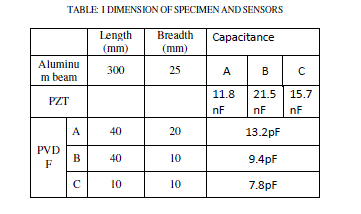 |
| Schematic diagram of the aluminum beam with PVDF and PZT patches are shown in Fig: 5 (a & b). Fig: 5 (c) shows the actual specimen used for the experiments. |
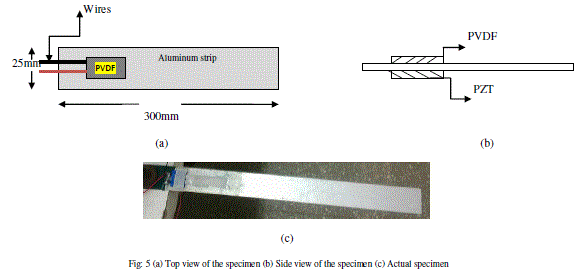 |
| The experimental block diagram is shown in Fig: 6. The input signal applied to PZT actuator was set us 10V peak to peak and offset voltage 0V using Tektronix AFG 3022B signal generator. The frequency of the signal generator is varied from 10Hz to 450 Hz to calculate the impact of vibration on PVDF sensor output. By varying the signal generator frequency interval, vary the vibration of the aluminum beam and the PVDF voltage monitored continuously on LeCroy wave Surfer 64X5A oscilloscope. |
 |
RESULTS AND DISCUSSIONS
|
| The output voltage obtained from PVDF film for different frequencies are noted on the Table II. Input signal voltage from signal generator is set as 10V peak to peak for all the experiments. |
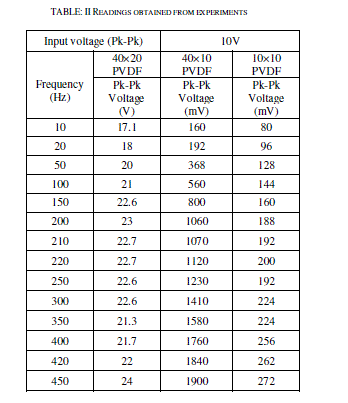 |
| Based on the values in table: 2 graph is plotted as in Fig: 7. From the graph we can observed that the output voltage for 20×40 mm PVDF film is higher as compared to the other two PVDF. Since the output voltage of 10×10 mm PVDF film is in mV range it cannot be rectified with a common bridge rectifier circuit. Hence the comparison is carried out on the basis of output peak to peak voltage. For the three PVDF films the output voltage increases with increase in the frequency. |
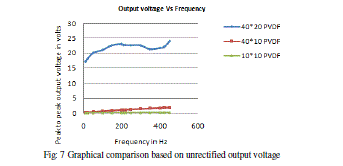 |
| Output voltage obtained from a 40×20 and 40×10 can be rectified using a common bridge rectifier circuit as shown in Fig: 8. Diode used for rectification is schottky diode (BAT85). Also capacitor filters (1000μF) with resistive load (5.4KΩ) used. Rectified output voltage across the resistor was measured on Yokogawa JKL 4035 digital multimeter and listed on Table: III. Based on these data we can calculate the amount of energy harvested using the equations 1 and 2. |
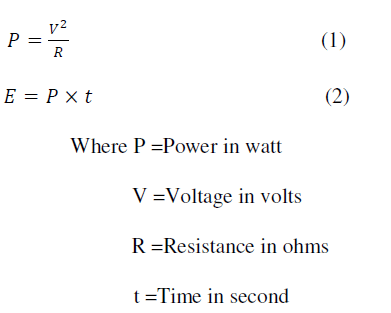 |
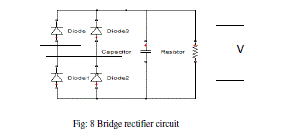 |
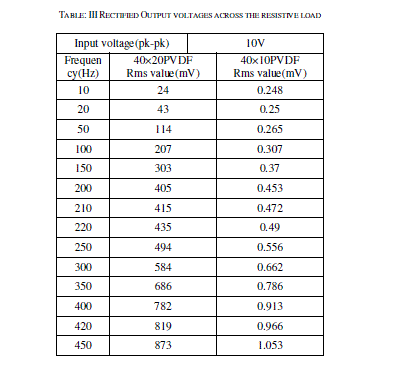 |
| Energy is calculated and listed in Table: IV. Energy Vs frequency graph is plotted in Fig: 9. |
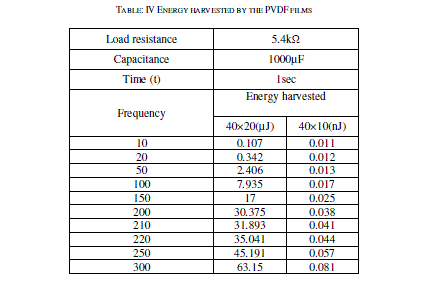 |
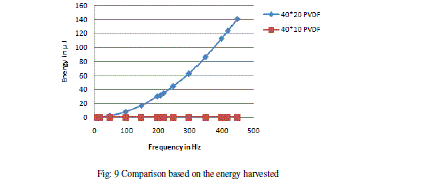 |
| The experimental result showed that as the area of contact of PVDF film increases the energy harvested also increases. This means that as the dimension of PVDF increases its capacitance value also increases, hence the energy harvested also increases. |
CONCLUSION
|
| Experiments are carried out using different dimensional PVDF film on the aluminum cantilever beam and comparative study is carried out. In summary, to scavenging high energy from mechanical vibration PVDF film with higher area of cross section is required. Due to the flexibility advantage of PVDF film it can be used on any curved surfaces as compared to brittle PZT sensors. The energy harvested at 450 Hz of the PVDF of dimension 40×20 is around 141μJ is the highest energy harvested in the experiment done. This harvested energy can be used for low power applications like nano powered microcontroller for smart structure applications. |
ACKNOWLEDGMENT
|
| Authors would like to thank Mr. Shyam Chetty, Director CSIR-NAL, Dr. Satish Chandra, Head STTD, Mr. Surendra C, Technical officer STTD, Mr.Jayanth Kumar S, Project assistant MSD, Mr. Prithip Kumar P, Project trainee STTD of CSIR-NAL for their help and encouragement and Prof K Radhakrishnan, Head of the Department, Electrical & Electronics, M A College of Engineering, for the encouragement to carry out this work. |
| |
References
|
- VireshWickramasinghe, David Zimcik, and Yong Chen “A Novel Adaptive Structural Impedance Control Approach to Suppress Aircraft Vibration and Noise” Structures, Materials and Propulsion Laboratory, Institute for Aerospace Research National Research Council Canada, Ottawa, Ontario, Canada K1A 0R6
- YonggangJiang ,SyoheiShiono , Hiroyuki Hamada , Takayuki Fujita Kohei Higuchi and Kazusuke Maenaka1 ”Low-Frequency Energy Harvesting Using A Laminated Pvdf Cantilever With A Magnetic Mass” Maenaka Human-Sensing Fusion Project, Japan Science and Technology Agency, Himeji, Japan
- Xuan-Dien Do, Chang-Jin Jeong, Huy-HienNgugen, Seok-Kyun Han, and Sang-Gug Lee “A High Efficiency Piezoelectric Energy Harvesting System”978-1-4577-0711-7/11/$26.00@2011 IEEE
- Francesco Cottone Marie Curie Research Fellow ESIEE Paris – University of Paris Est“Introduction to Vibration Energy Harvesting” NiPS Energy Harvesting Summer School August 1-5, 2011
- www.wikipedia.org/Lead zirconium titanate
- www.sparklerceramics .com
- Chilibon,C.Dias,P.Inacio“PZT and PVDF bimorph actuators”Journal of optoelectronics and advanced material vol 9 ,no 6,June 2007 ,Page 1939-1943.
- HyungooLee , Rodrigo Cooper , Ke Wang , and Hong Liang “Nano -Scale Characterization of a Piezoelectric Polymer (Polyvinylidene Difluoride, PVDF)” Sensors 2008, 8, 7359-7368; DOI: 10.3390/s8117359.
- www.wikipedia.org/polivinylidene difluride
- Hiro Han, Yuusaku Nakagawa, YasuyukiTakai, Kunitomo Kikuchi, Shigeki Tsuchitani“PVDF film micro fabrication for the robotics skin sensor having flexibility and high sensitivity” 2011 Fifth International Conference on Sensing Technology
- ChetanByrappa, B S Ajay Kumar and Anupama H “Applications Of Pvdf”International journal of mechanical engineering and Robotic research India ISSN 2278 –0149 www.ijmerr.comVol. 2, No. 1, January 2013
- MichalWachlaczenko“The Influence Of Wing Tran sverse Vibrations On Dynamic Parameters Of An Aircraft” journal of theoretica and applied mechanics 48, 2, pp. 397-413, Warsaw 2010
|